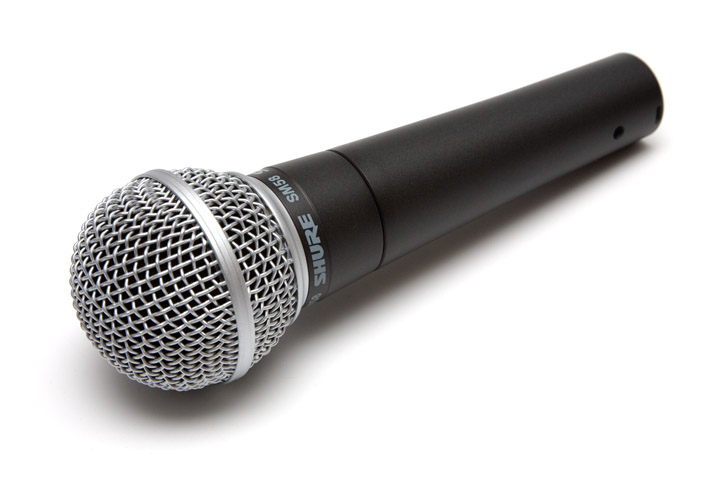
Image by Nicolas Esposito (CC BY 2.0)
The following review discusses Midi Film Scoring’s picks for the best affordable microphones: Sennheiser e85 vs Shure SM58 vs Electro Voice N/D767a.
Today’s sample libraries are getting increasingly more realistic, but nothing beats the sound of a live-recorded instrument. Even just one or two live-recorded audio tracks layered with your virtual instruments can make all the difference between a mix that sounds MIDI’d and one that’s hard to tell apart from a real performance.
There are a lot of good microphones on the market across a wide spectrum of price points, and it can be hard to narrow it down to one product, especially if you’re just getting started recording your own music. If that’s the case, I recommend starting small and going for the best quality microphone you can find at an affordable price.
A budget-friendly way of building a microphone kit is to look for multipacks. The price per microphone is cheaper, and many recording situations will require at least a couple of the same microphones to get a great sound. I always suggest that you start with a few good, general-purpose, dynamic microphones, as they are very rugged and they don’t require phantom power.
Sennheiser e835 Microphone 3-Pack
Transducer: Dynamic
Polar Pattern: Cardioid
Frequency Response: 40Hz to 16kHz
Enclosure: Handheld
Accessories: Soft pouches, mic clips
The “e” means this mic is part of their “Evolution” series, or what Sennheiser terms as “a microphone for specific purposes.” While the e835 is considered a live vocal microphone, it’s a very good general-purpose mic as well — the Sennheiser demo video actually shows it being used to mic a snare.
As always, Sennheiser microphones have that professional construction that’s highly prized by musicians who get around a lot.
This mic is a really great choice for electric and acoustic guitars, drums, and, of course, vocals. If you’re familiar with the sound of dynamic mics, you might be surprised by the high-frequency response. I like using this microphone when recording loud sound effects such as engines and industrial hardware, as it can take the high-volume levels and still provide full-range frequency response.
I find it can be a bit susceptible to feedback when using it for live vocal usage. The low-frequency mechanical dampening can become problematic, but this can be remedied with a better mic clip setup.
Shure SM58 Microphone 3-Pack
Transducer: Dynamic
Polar Pattern: Cardioid
Frequency Response: 50Hz to 15kHz
Enclosure: Handheld
Accessories: Soft pouches, mic clips, cable ties
Don’t make me tell you what SM stands for! This is the industry standard for live vocal microphones, though the Beta version is quickly becoming more popular.
This is a very good general-purpose mic, and it sets the standard in rugged construction. I like to show this video to students:
You should always have at least one of these microphones, and this 3-pack is a very good deal. This mic is a really great choice for brass, electric guitars, strings, drums, and all sorts of pop vocals, although you may find that it is not sensitive enough for softer vocals styles.
The frequency response is very flat, so it works very well in recording sounds that need a wide range, but this can also result in less presence.
This is my go-to microphone for everything from testing a system to recording one-time-only sound effects to just saving my butt when problems occur. If you’re recording a loud sound effect, this microphone can take the SPLs. My SM58s have never let me down!
Electro Voice N/D767a Microphone 3-Pack
Transducer: Dynamic
Polar Pattern: Cardioid (specified as supercardioid but, in application, seems inaccurate)
Frequency Response: 35Hz to 22kHz
Enclosure: Handheld
Accessories: Soft pouches, mic clips, XLR cables
This microphone is probably the best multi-purpose microphone available, and prices have dropped due to a lot of kit agreements from EV. The microphone is not only as sturdy as dynamic transducers, but it also has much better clarity than many condenser mics at the same price point, so you really get the best of both worlds.
I like to use these mics in all sorts of stereo and M-S sound effects and recordings, especially with louder sounds. If you’re going to be recording instruments that have a specific sound profile, like banjo, flute, sax, etc., the 767 can get all the loud and all the soft parts of a nice recording.
There’s also a pretty sophisticated shock-mount built into the microphone that really does a good job of eliminating mechanical sounds. I have found these mics to be very quiet when I’m doing surround mixes from live bands’ performances (hence why I don’t really feel that they are supercardioid as per the EV specifications).
The low S/N makes them really good for spatial recording needs as well as recording the clear sounds of a great artist. While all of my 767s work well, I have worked with bands that have one or two that are non-functional, but who knows what these guys get up to on a gig — like I said, I haven’t had any issues.
The Bottom Line
If you’re on a budget, dynamic microphones might be the way to go. They’re very rugged, they don’t need phantom power, and they can deliver great sound. Every audio person seems to own SM58s, and they’re great mics. The 835s sound a little better in recording situations at the same price.
The 767s will give you better quality and you might be able to find them at the same price as the other mics (I find mine very rugged, but like I said, I’ve also seen other people’s 767s that don’t work).
All of these kits are very good purchases, but you have to own some SM58s — it’s an audio engineer rule!
What are your top picks for high-quality budget mics? The comments are open!
Leave a Reply